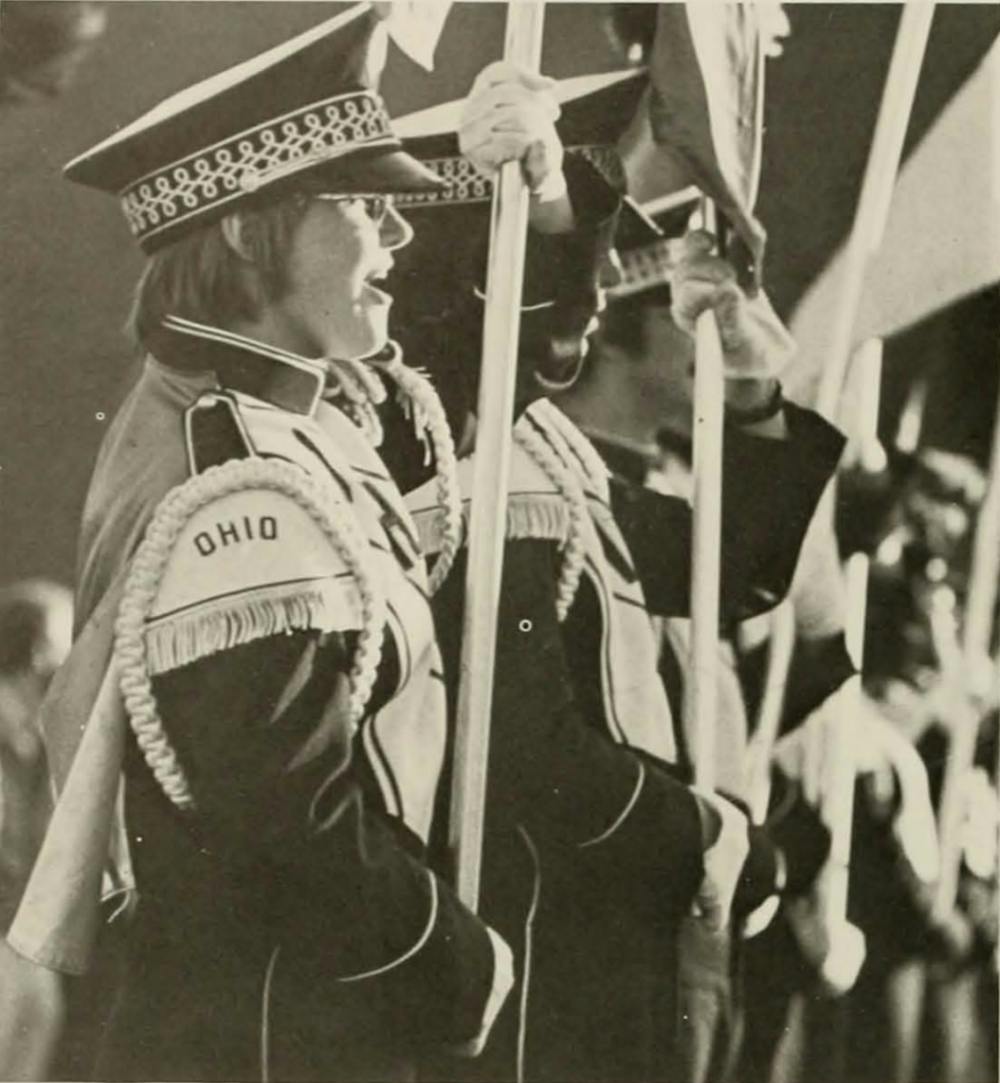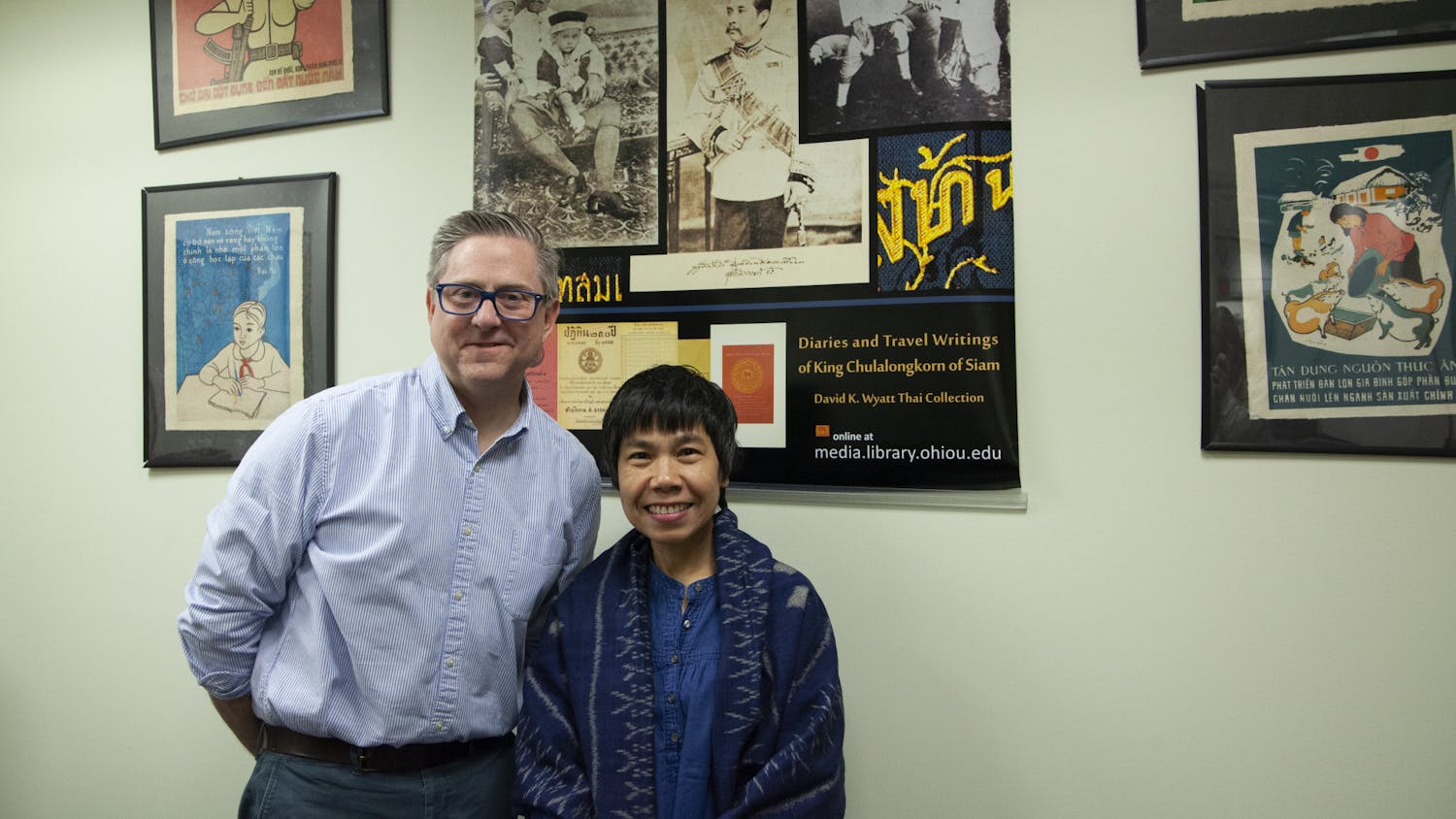TJ Azar tore up several other college applications after hearing the Ohio University Marching 110 would be accepting women during the 1975 season.
“It was my single decision to come to OU,” Azar, a 1979 alumna, said.
Starting in 1967, women were excluded from the Ohio University Marching Band, — its name at the time — but after pushback and media attention, women were eventually allowed to audition again, eight years later.
At the time, Azar said there were uncertainties about whether women would be accepted and if it would be a smooth transition.
“My father, who veered me to believe I could do anything ... for the first time he said, ‘You know TJ, this may not work. This may not happen,’ ” Azar said.
Despite her father preparing her for disappointment, Azar became one of six women to be accepted into the Marching 110 that year. The 2015-16 season marks the 40th anniversary of the band’s reinclusion of women.
Exclusion creates controversy
In 1967, the style of the Ohio University Marching Band shifted. The removal of women and majorettes — more commonly known as baton twirlers — were paired with a change in marching style, uniforms and instrumentation. The band removed piccolos and flutes, predominantly played by women at the time, and subsequently increased its brass section, which was mostly played by men.
The band soon adopted the name the Marching Men of Ohio.
Gene Thrailkill, director of the band from 1967 to 1970, made the decision to remove women, making the marching band the first one to do so in the Mid-American Conference, according to a previous Post report.
“We can work men harder and the ‘esprit de corps’ will be greater,” Thrailkill said in a previous Post report.
The campus resisted the change, Josh Boyer, current assistant director of the Marching 110, said. Students spoke out and local papers wrote editorial pieces criticizing the decision to ban members based on sex.
The Post editorial staff in 1967 questioned the changes taking place and challenged the marching band’s decisions.
“Can’t women be worked as hard as men?” asked the previous Post editorial. “And isn’t coed band conducive to ‘esprit de corps’? In the University’s quest for big-time recognition in sports, must it sacrifice originality?”
The controversy settled, however, following the band’s first performance, which Boyer said showcased a new athletic style. During the same time that the band excluded women, it began incorporating contemporary pop-rock music as well as dance moves into its performances.
Now known as a tradition for post-game shows, the routine to blues piece, “Ain’t Been Good,” was the band’s first-ever dance number, which was performed in 1968.
While some of the changes in style started to be accepted, women’s exclusion from the band continued to be a point of concern from an educational standpoint.
Without the opportunity to play in a college band, female music majors struggled to find jobs in teaching positions following graduation.
“I talked to recently graduated (music majors) who said, ‘Look, we can’t get jobs that men can because if you haven’t been in a college band, it’s much harder to get a job in a high school as a music teacher and there aren’t that many jobs for music majors aside from teaching,” Beverly Jones, a 1969 alumna, said.
Fueled by her desire for equality, Jones, formerly Price, crafted the “Report on the Status of Women at Ohio University” in 1972. In the report, she suggested “students not be excluded from the band on the basis of their sex.”
The report included information detailing the number of women employed at the university at the time and the amount of athletic scholarship money that favored men. Jones used the band as an example of inequality because it hadn’t always excluded women.
“I thought (the band), as a symbol of how women were treated and regarded, was really powerful,” she said.
Jones said she received a lot of objection to the report because some did not favor giving opportunities and resources to women if it meant taking some away from men.
“Every place I went people said, ‘You killed the band. We had a wonderful band and it’ll never be the same. You finished off the band,’ ” she said.
Peacefully coed
Title IX is the federal law that prohibits discrimination in educational programs based on sex. Although the law was passed in the same year as Jones’ report, women were not reincluded in OU’s marching band for another three years.
Bands across the country, such as bands at The Ohio State University and Penn State University, had been reincluding women, and OU followed suit, Boyer said.
The director during the 1975 season, Ron Socciarelli, who died in 2012, enforced the reinclusion to assure the band’s reputation went untarnished.
“Socciarelli did a great job with it,” Chris Bumpass, a trumpet player from 1972-76, said. “He explained to people, ‘This is the way it is. Get over it.’ And they got over it.”
Socciarelli spoke with Azar years after she graduated and expressed his feelings about women being admitted back into the band.
“He made it clear that he was determined that this transition would go well and smoothly, and nothing would be wrong with the character that has been built in the band,” Azar said. “I think he did that.”
In those first years of reinclusion, Bumpass said the male band members had reservations, but their concerns soon subsided.
“When everyone found out the ladies coming out for the band didn’t want to be the ‘first women in the band,’ they just wanted to be in the band ... that made the transition great,” he said.
Colleen Keener, another one of the six women who made it into the band in 1975, said auditioning would have been intimidating regardless because she wanted nothing more than to be a part of it.
The band, music and performance are most important to the 110. Everything else is secondary, Azar said. The shared goal brings people together.
“For 12 minutes on the field every Saturday, we were one,” Azar said.
Lasting tradition
Despite the notoriety of part of its history, the Marching 110 embraced some of the changes made in 1967 and has turned them into significant components of the band’s modern style.
The band still does not include flutes nor piccolos, a lack that has created the 110’s signature sound.
Boyer stated that if someone returned to campus for the first time since 1975, that person would recognize the Marching 110 based on tradition.
Even though traditions stem from that time period, some band members would not want history to repeat itself.
“If that same change would have happened today, it would break my heart,” EmmyRae Watson, who is a mellophone player and a senior studying music education, said. “I think it’s incredible how far women have come in this band and all across the university — how we’ve come to be one with no separation.”
@liz_backo
eb823313@ohio.edu






